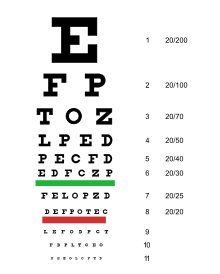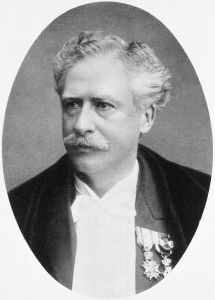 As eye doctors, we will often get asked the question…
As eye doctors, we will often get asked the question…
“So what exactly is my vision?”
For us, it is very easy to simply answer this question by giving the patient a number: 20/20, 20/50, 20/100, etc.
BUT WAIT A SECOND!!
- What exactly are these terms?
- Who invented them?
- How did they come to be used to describe vision?
- What do these measurements really say about the quality of your vision?
Today I will answer those questions and more!
Why are numbers like 20/20 important?
The first thing to understand is that these values for vision (which we call visual acuity) are simply that: values or amounts. It is no different than adding 10 gallons of gasoline to your tank or using 2 cups of flour in a cake recipe. What makes these numbers so important is that (like gallons, cups, or feet) these visual acuity levels are standardized.
Covering an eye and reading a sign across the parking lot, doesn’t tell eye doctors very much about your vision. However, with a standard visual acuity measurement, any eye doctor, at any time, or at any location knows immediately how well the patient saw the vision chart that day.
This allows us to monitor vision over time and to measure how much vision improvement a patient receives through medical treatment or a new prescription.
Where did 20/20 come from?
 The first person to understand the need for a standardized way of measuring vision was a German ophthalmologist named Heinrich Keuchler. Around 1842, Keuchler created the very first visual acuity chart. Actually, he created 3 different ones to prevent his patients from memorizing the letters… you all know who you are.
The first person to understand the need for a standardized way of measuring vision was a German ophthalmologist named Heinrich Keuchler. Around 1842, Keuchler created the very first visual acuity chart. Actually, he created 3 different ones to prevent his patients from memorizing the letters… you all know who you are.
A few years later in 1862 the vision chart was refined even further by Herman Snellen (pictured right) who created what he called optotypes. Optotypes are simply specifically sized characters printed in a grid form. This ingenious decision to start using standard font sizes of the time made these charts easily reproducible and they quickly became the global standard.
So popular was this invention, that the vision chart you read at the doctor’s office today still bears his name and the Snellen Chart (above) has sold more copies since it’s invention than any other poster in history!
Another fun fact about the Snellen and other vision charts is that the letters G, I, J, M, Q, W, X, and Y never appear. See, reading the chart isn’t that hard, I just made it even easier!
What do the numbers in 20/20 stand for?
When Snellen first designed his reading chart, his optotype characters were meant to be read from 20 feet and if you could, you were considered 20/20. Therefore, the first 20 in 20/20 simply stands for 20 feet. This distance is important because past 20 feet the focusing of our eyes is the same as it is for any distance further out. This distance is called “optical infinity” and is the distance that vision is measured. In the past, it wasn’t uncommon to be examined in 20 foot long exam lanes. These days however, it is far more common to use electronic charts or to incorporate mirrors to make the Snellen chart seems further away.
The second 20 in 20/20 is a little trickier to understand, but it basically compares how well you can see the chart compared to a normal 20/20 person.
For example, what if your vision is not the perfect 20/20 but only 20/40?
Well, this means that the smallest line of letters you can read at 20 feet is the same as for someone with normal vision who is 40 feet away. And, if you could only see the 20/100 line of letters at the standard 20 feet, a normal person could see those same letters from 100 feet away. This system is the same for every other measurement in between like 20/30, 20/80, 20/200, etc.
It also works the other way. If you are blessed enough to have better than normal vision at 20/15 or even 20/10 vision, then you can see at 20 feet what a normal person can only see at 15 or 10 feet.
Best Corrected Vision
The last thing that it is important to discuss when it comes to visual acuity is the concept of Best Corrected Vision. Best corrected vision is the very best that you can see when you have the best glasses or contact lens prescription possible. This is typically the way that visual ability is described.
Therefore, the question of, “What is my vision without glasses” really isn’t important. If you take your glasses off and can barely see the “Big E” on the Snellen Chart (which is 20/200) but with glasses you easily read the 20/20 line – you are not legally blind, your vision is considered the normal 20/20.
I hope this has cleared up some confusion around visual acuity, but if you have any additional questions or topics for future discussion, please contact me at [email protected].
We love to educate!
Thanks again for stopping by and take care of those eyeballs!!
- Nick Wolf, OD


